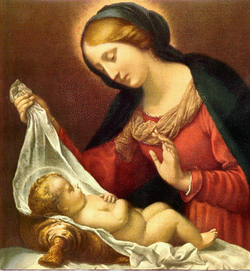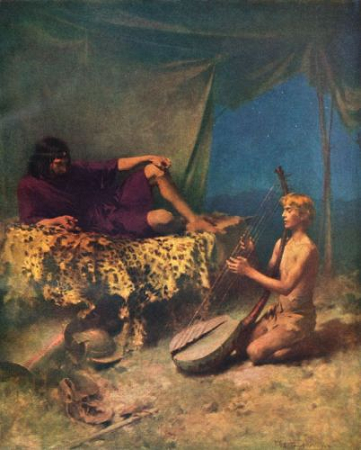
We continue with a summary of The Star of Bethlehem: The Star that Astonished the World. Chapter Five is scholarly, dedicated to scriptural reference and fascinating in scope. Included are wonderful illustrations of the astronomy appropriate to the time. DR Martin delves into the Word to determine the hour of the birth of Jesus. It is amazing how close to scripture he cleaves. Following are selected quotes from The Time of Jesus' Birth (Chapter Five), by DR Ernest L Martin.
"The suggestion was made in the last chapter that the Magi presented their gifts to Jesus on December 25, 2 B.C.E. This was not, however, the time of his birth. When the Magi arrived, Joseph and Mary were no longer in a stable with Jesus. They were now residing in a house (Matthew 2:11). Jesus had been circumcised (Luke 2:21) and dedicated at the temple some forty days after his birth (Luke 2:22–24). He was then being called a paidion (toddler) and no longer a brephos (infant). When the Magi arrived, Jesus was already walking and was able to speak a few words as most normal children would be able to do when several months old. Soon after the Magi left, Herod killed the male children in and around Bethlehem who were two years of age or younger (Matthew 2:16). This does not mean Jesus was exactly two years old at the time. The fact that all children two years and under were slain shows that Herod was taking every possible interpretation of the Magi into account for the time of Jesus’ birth.
"There is biblical information which could go a long way in helping us understand the general time period for Jesus’ birth. Luke gave more chronological data regarding the birth and ministry of Jesus than any other biblical writer. In doing this, Luke began his story with John the Baptist. He gave some chronological indications as to the time of John’s conception and birth. Though his statements are general, they are plain enough to indicate the approximate time of John’s birth, and consequently that of Jesus himself. This chronological information is found in Luke’s first chapter. Note what Luke said, “There was in the days of Herod, the king of Judaea, a certain priest named Zechariah, of the course Abijah and his wife was of the aughters of Aaron, and her name was Elizabeth.” Luke 1:5
"This verse tells us something about the parents of John the Baptist. Zechariah was a priest whose duty it was, on certain occasions, to offer the national sacrifices in the temple at Jerusalem. While he was accomplishing his assigned requirements, Luke said an angel came to him and told him that his wife Elizabeth would bear a child. Zechariah could hardly believe what he was told because Elizabeth was beyond the age of childbearing. The angel understood his reason for disbelief; so, Zechariah was struck dumb to prove the certainty of what was prophesied. When Zechariah came out of the inner temple, the people perceived that he had seen a vision and were amazed that he was unable to speak. They realized that something significant had been pointed out to Zechariah..."
According to DR Martin, there were 24 Courses that were considered to be calendar indications. He continues to delve into their chronology.
He discusses the year of the birth of Jesus:
"If Jesus was about 30 years old near the commencement of the emperor’s 15th year (as reckoned by people in the east), then His birth was in 3 B.C.E. Recall that Luke tells us that Jesus was born at the time of a Roman census or enrollment. If we can determine the period of that registration, this will help to pinpoint the year of the nativity. This is where the new historical information offered in this book becomes essential. We now know that an Empire-wide citizen registration took place for the award of the Pater Patriae upon Augustus in early 2 B.C.E. 3 This was the census Luke meant. I will give a full account of this registration (a census) in a further chapter of this book titled “The Census of Quirinius” (Chapter 12). But let me briefly rehearse some of the evidence that shows when the census mentioned in the New Testament took place."
The Census of Quirinius, The Birth of John the Baptist, and the Eight Course of Abijah are studied. Then Ernest returns to the birth of Jesus:
"Let us now look at the birth of Jesus. From what we have observed about the approximate time of John’s birth, it should be easy to compute that of Jesus. Luke said that Jesus was conceived sometime in the sixth month of Elizabeth’s pregnancy (Luke 1:26, 36). Five full months had passed and Elizabeth was then in her sixth month. Since John the Baptist was probably born some time around March 10, 3 B.C.E., Jesus’ birth would be near September in 3 B.C.E. We will soon see from other astronomical data that this is the only year that will satisfy all the facts. It must be admitted that it is impossible to arrive at an exact birthday for either John or Jesus based on the priestly courses, yet the information provided by Luke helps us to pick the approximate periods with some confidence. Two or three weeks each way would be the outside limit."
He picks a date, and then elaborates on the time. He determines it was the time of the New Moon, and references scripture to back up his reasoning. DR Martin concludes:
"What a significant day for the appearance of the Messiah to arrive on earth from the Jewish point of view! And remarkably, no other day of the year could astronomically fit Revelation 12:1–3. The apostle John is certainly showing forth an astronomical sign which answers precisely with the Jewish New Year Day. John would have realized the significance of this astronomical scene that he was describing."
"“And there was a great wonder [sign] in heaven; a woman clothed with the sun, and the moon under her feet, and upon her head a crown of twelve stars: and she being with child cried, travailing in birth, and pained to be delivered. And there appeared another wonder [sign] in heaven; and behold a great red dragon, having seven heads and ten horns, and seven crowns upon his head. And his tail drew the third part of the stars of heaven, and did cast them to the earth: and the dragon stood before the woman which was ready to be delivered, for to devour her child as soon as it was born. And she brought forth a man child, who was to rule all nations with a rod of iron.” Revelation 12:1-5"
You can read or listen to The Star of Bethlehem: The Star that Astonished the World at the ASK ELM website.
You can also listen to David Sielaff’s wonderful audio interview with George Ann Hughes at the Byte Show. These files bring us up to date, for David Sielaff continues the work of Ernest L Martin today. You will find the full interview at The Byte Show. Scroll way down to The Star of Bethlehem series, in fourteen parts.
Also available are all eleven parts of The Star of Bethlehem interviews Ernest L Martin did with Jeff Rense at ASK ELM.
___________
Martin, Ernest L. “The Star of Bethlehem: The Star that Astonished the World.” 21 DEC 2012 <http://www.askelm.com/star/star006.htm>
You can purchase the hardbound version of The Star of Bethlehem: The Star that Astonished the World, by DR Ernest L Martin at
amazon.com.

 RSS Feed
RSS Feed